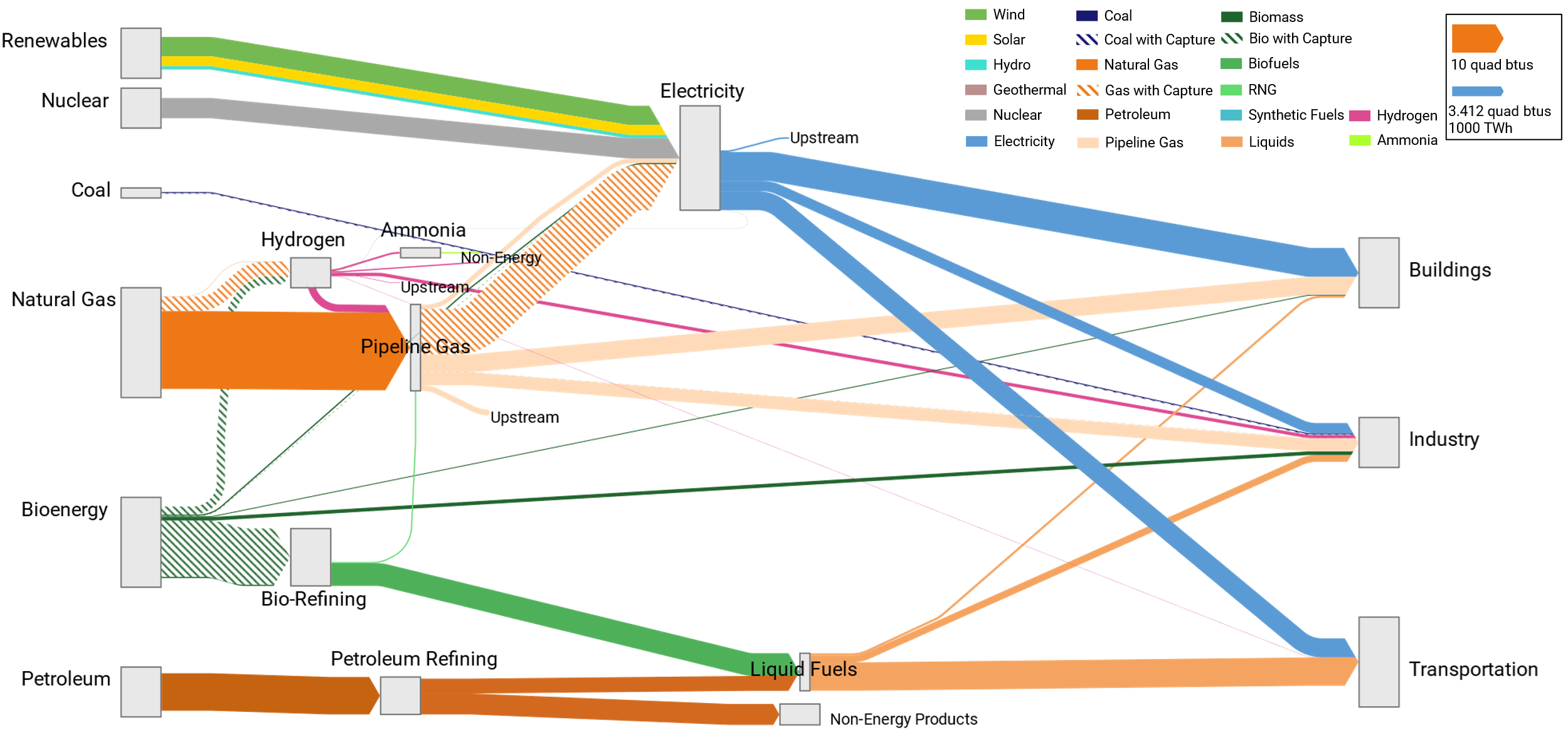Net-Zero All Options Scenario

In the Net-Zero All Options scenario, there are several significant changes to the energy system relative to the Reference scenario, particularly to the supply of electricity and liquid fuels. Projected economy-wide energy flows in 2050 are shown in Figure 12. In electric generation, renewable generation shares reach nearly 50%, and new natural gas capacity with carbon capture provides around 35% of generation. Existing nuclear capacity is largely maintained with license extensions, and all existing coal capacity is retired. Additionally, the electric sector maintains and expands conventional (i.e., without carbon capture) gas-fired capacity, which—along with new investments in battery storage—provides balancing for intermittent renewable generation. Capacity mix results are distinct from the energy mix pictured in Figure 12 and are discussed further in the Electricity section (see Figure 22).
Demand for liquid fuels in 2050 in the Net-Zero All Options scenario is much lower than today due to the electrification of transportation. However, remaining demand is met with a larger share of biofuels than in the Reference scenario, in particular renewable gasoline, diesel, and jet fuel produced from cellulosic bio-feedstocks. Importantly, this biofuel production employs CO2 capture and geologic storage of process emissions (which are significant given the thermal losses in conversion), yielding a negative flow of carbon from the atmosphere. This negative emissions flow allows some positive emissions to remain in other parts of the economy while still achieving the net-zero target.
Thus, CCS plays a key role in both the electric sector (used with new natural gas capacity) and the liquid fuels sector (used with bioenergy). CCS is also used in the production of hydrogen from natural gas and bioenergy, which expands to include hydrogen use as a fuel in addition to its current uses as an industrial gas. Hydrogen is used both directly in fuel-cell vehicles, particularly non-road vehicles in construction, agriculture, and mining, and indirectly as a blend with natural gas in existing gas infrastructure. CCS is also used with coal for process heat in the steel and cement industries.
The net-zero target creates stronger incentives for electrification and efficiency in the buildings and industry sectors, but the incremental effects relative to changes already occurring in the Reference scenario are small. Final energy in 2050 in the Net-Zero All Options scenario is roughly 4% lower than in the Reference scenario, and the share of electricity in final energy is 43% compared to 39% in the Reference scenario. Note that these effects are slightly larger in percentage terms in the buildings and industry sectors, as there is slightly less electrification of transportation than in the Reference case due to the added value of biofuels in generating negative emissions. Natural gas is still consumed directly in buildings and industry for space and process heating, albeit with a small fraction of blended hydrogen and renewable natural gas. In the transportation sector, some residual CO2 emissions remain from jet fuel (which is partly offset with biofuels but mainly petroleum) and residual fuel in shipping (although most of the latter is displaced by renewable diesel). Thus carbon management from bioenergy with CCS (BECCS) allows a strategy to achieve economy-wide net-zero emissions that avoids potentially more costly transitions in the end-use sectors.